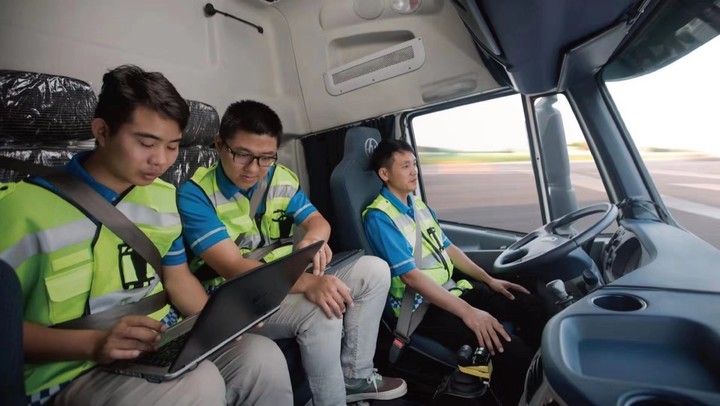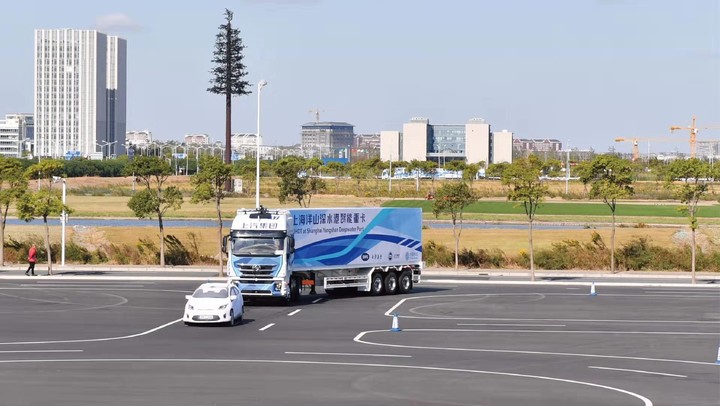From Shanghai’s deep-water port logistics park, through the Donghai Bridge, to the Yangshan Port terminal, a total of 72 kilometers, which is a famous logistics ring.
On this ring line, SAIC heavy trucks that have obtained the Shanghai Intelligent Network’s open road test license are actively carrying out demonstration operations of self-driving freight with AI, 5G, V2X car communication and other related technologies. It needs to face a variety of complicated scenes such as ordinary roads, highways, docks, yards, and large traffic flows at night, as well as the 7th-level winds on the East China Sea Bridge for two months each year.
It is understood that SAIC has independently developed a visual perception system, a laser radar system, a millimeter wave radar system, and a satellite and inertial navigation combination system. Its heavy trucks already have multi-dimensional, multi-directional 360-degree sensing capabilities, which can be used before and after. Accurately perceive traffic participants within a range of approximately 80 meters from 250 meters to around, and accurately identify pedestrians, vehicles, and other obstacles, and plan the route.

Because the terminal container is densely packed, satellite signals are easily blocked. Therefore, SAIC heavy trucks mainly rely on high-precision maps, ground-enhanced positioning and visual laser sensing systems. V2X technology can interact with tire cranes and bridge cranes to achieve precise positioning. Accurate parking (±3cm) is completed in one second in 15 seconds, and the efficiency of single-point loading and unloading is increased by 10%.
With the 5G blessing, SAIC heavy trucks can build fleets within 20 milliseconds.Real-time interactive communication ensures that the automatic driving, lane keeping, bypass, emergency braking and other queue driving functions are realized instantly, and the distance between the queues is reduced from 150 meters to 15-20 meters under the premise of ensuring safety. .
In summary, the official claims that it has successfully achieved L4 level autopilot, centimeter-level positioning, precise parking (±3cm), interaction with automated port machinery equipment and the ability of the East China Sea Bridge to travel in a specific scenario in the port area.

In terms of vehicles, SAIC heavy-duty trucks use the natural gas engine + 12-speed automatic transmission as the power component. SAIC said that under this powertrain, vehicles will reduce nitrogen oxides (NOx) by 60% compared to conventional diesel-powered heavy trucks. And particulate matter (PM) pollutant emissions.
This heavy truck also incorporates an automatic cleaning device on the body to avoid the adverse effects of the environment on the accuracy of the sensing system after a long period of operation.
Whether it is difficult to realize the technical realization of commercial vehicles compared to the automatic driving of passenger cars? We interviewed the relevant technical leaders of SAIC Heavy Truck:
1, commercial vehicles are larger, have different heights, and have more dead ends. Therefore, SAIC Heavy Truck has made full coverage of the three-layer 360-degree sensing system.
2. A steel body of a car, a smart heavy truck with a trailer, and a flexible connection in the middle. The model and motion characteristics of the vehicle dynamics are different.Model construction, software development, and subsequent iterations of the control system and the vehicle’s execution system are required.
3. Under different scenarios, how to rely on the same software, according to the current load situation, natural conditions, wind speed of the car can achieve precise driving, vertical control lateral control.
The concept of autonomous driving in recent years is very hot, but there are very few real landings. In terms of passenger cars, the mainstream level is basically in the L2.5 level, and it is difficult to achieve real commercialization. However, commercial vehicles in closed scenes or fixed lines are just easier to achieve. The difficulty of recruiting drivers and the high cost are also forcing the pace of unmanned commercial vehicles to move forward quickly.
